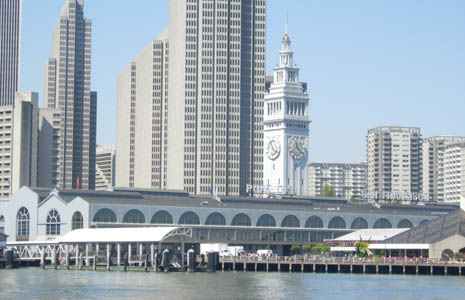Perhaps all or none of the above. On Monday, January 6, Google debuted its private ferry service connecting San Francisco’s Ferry Building to the Port of Redwood City, near Google’s main campus.

The new “Google Ferry”, which debuted its private service on January 6, runs twice a day from the San Francisco Ferry Building to the Port of Redwood City. Photo by Joel Williams
BC Staff Editorial
Published: February, 2014
Is it a game-changer for comprehensive regional ferry service or is it the proverbial tempest in a teapot? Laudable corporate initiative or worrisome precedent?
Perhaps all or none of the above. On Monday, January 6, Google debuted its private ferry service connecting San Francisco’s Ferry Building to the Port of Redwood City, near Google’s main campus. The initiative, which saw two morning and two evening runs each weekday, was rumored to be a 30-day test. It is unclear if the service would continue after the test was concluded, though rumors also swirled that Google was preparing a second test of ferry service connecting Harbor Bay and Redwood City.
Fairly or unfairly, “Google Buses” have become a lightning rod for San Francisco residents who are fearful of displacement by newly-arrived, youthful tech workers with seemingly unlimited amounts of money. The “Google Ferry” adds a new dimension to this issue and has sparked lively debate among ferry advocates about why a private company—and not the Water Emergency Transit Authority (WETA), the public agency charged with coordinating comprehensive regional ferry service—is running service to Redwood City.
The answer turns out to be resources. Public ferry service to Redwood City currently ranks as a low priority for WETA planners because projections show decidedly low ridership potential. Cash-strapped WETA—already burdened with operating existing services in Alameda and Oakland and getting new service connecting the East Bay and South San Francisco off the ground—seems unlikely to get behind service to Redwood City anytime soon.
WETA was created with a broad mandate of ferry and emergency planning, but has been hampered by limited resources. Still, the agency can point to some key successes. It took the reins of the Alameda/Oakland and Vallejo ferry services, a torturous process that involved shouldering significant financial responsibility from the cities giving up these services. The Harbor Bay ferry service, once in danger of cancellation due to poor ridership, now thrives. The new South San Francisco ferry is similarly showing impressive ridership gains despite a shaky start.
WETA has also drawn down some of the $250 million in bonding authority granted to it for planning regional emergency preparedness to repair crumbling docks and build needed ferry maintenance facilities. And the agency has also quietly yet doggedly gone through the paces of planning for expanded ferry service to communities like Richmond and Berkeley.
Yet WETA remains limited by monetary and personnel resources, and further expansion will be a slog. Accordingly, private ferries may represent the only opportunity for expanded ferry service in the foreseeable future. But many questions about private ferries remain, such as whether private ferries will share equipment and crews with public ferries, or whether private ferries will participate in coordinated emergency response plans.
Privately operated ferries are not new on San Francisco Bay. The Tiburon ferry is privately operated by Blue & Gold Fleet. Unlike the Google Ferry, however, the public is welcome, even though Blue & Gold gets no public subsidy for operating the Tiburon route. Red and White Fleet also operated, albeit briefly, a ferry connecting Richmond and San Francisco.
But a private commuter ferry not open to the public will no doubt continue to rub transit advocates the wrong way. For those who want to see more public ferry transit on the Bay, seeking more funding is an obvious first step. To that end, key counties like Alameda are in the early stages of preparing sales tax measures for public transit. Bridge tolls are also likely to be raised. Ferry advocates need to be in the forefront of such discussions making the case for more money for ferries, because competition for these funding sources will surely be fierce.
An additional impediment to ferry expansion is WETA’s other unfunded mandates, the largest of which is regional emergency preparedness. If proper funding to complete the massive task of building and maintaining the infrastructure needed for a vast network of emergency preparedness is not available, maybe another agency or the state itself should take over the task. Ferry advocates also need to put aside demonstrably unrealistic hopes of yesteryear for comprehensive regional ferry service. That buccaneering vision called for ferry service to over 30 communities around the Bay along with the major airports, and, while laudable, is simply is not in the realm of the possible.
Ferry advocates would do well not to get too concerned about the Google Ferry and to rally behind new approaches that strengthen the existing network. Even before the Google Ferry pressed the issue, legislators were taking action of their own that could have a negative impact on ferry service.
For example, Assemblyman Jim Frazier (D-Antioch) has introduced a bill that would revamp the board makeup of WETA with a view to forcing ramped-up planning for a ferry service to Antioch. Such moves, if successful, could see funding for WETA success stories like Alameda and Vallejo diminished in favor of pipe dream projects like ferry service for Antioch or Port Alviso (San Jose).
The bottom line is that ferry advocates need to decide what they want to be when they grow up. Private initiatives like the Google Ferry should be welcomed when they provide services to communities that otherwise have no expectation of service. New public service to aspirant communities like Richmond should be championed. But first and foremost, existing success stories—namely ferry service in Alameda and Vallejo—should be protected and strengthened. That means making a priority of securing resources for core services.


